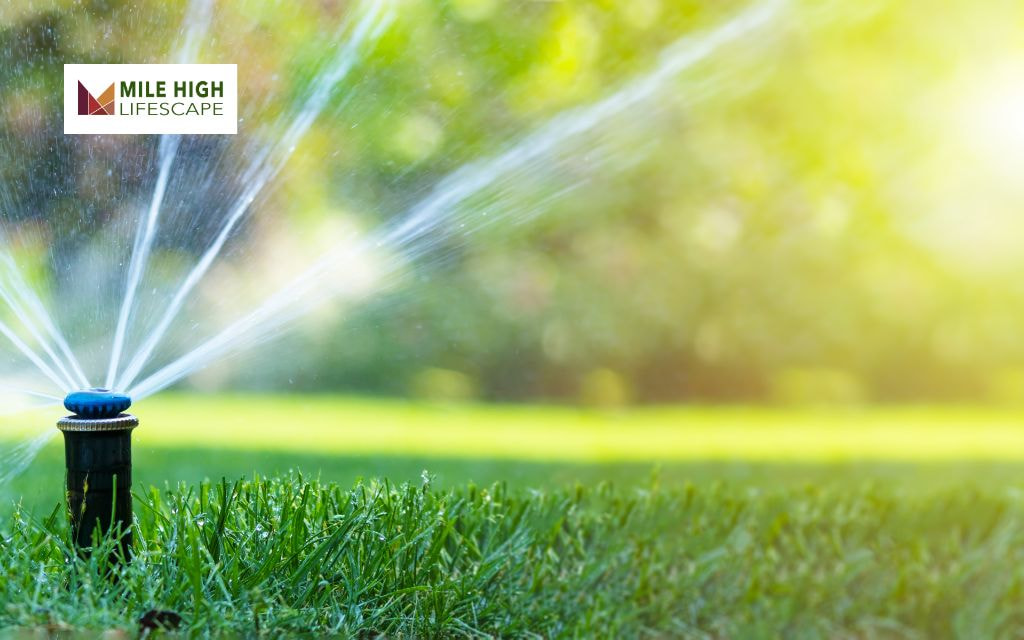A lush, green lawn transforms any property into a showcase. Yet many homeowners struggle with maintaining healthy turf despite their best efforts. The disconnect often stems from misunderstanding lawn fundamentals and overlooking critical care practices. At Mile High Lifescape, we’ve compiled 15 proven lawn care strategies that deliver exceptional results through science-backed methods and professional expertise.
Sharpen Your Mower Blades Regularly
Dull blades tear grass instead of cutting it cleanly, creating entry points for disease and stunting growth. Sharp blades produce clean cuts that heal quickly and maintain lawn health.
- Sharpen blades after every 20-25 hours of mowing time
- Watch for warning signs: grass appears ragged after cutting or shows brown tips
- Clean cuts heal faster, reducing stress on your lawn and improving water retention
Mow at the Right Height
Each grass type thrives at specific heights. Understanding your grass species requirements prevents common damage.
The one-third rule stands as the most important mowing principle: never remove more than one-third of the blade height in a single mowing session. Cutting too short (scalping) weakens root systems and creates opportunities for weeds to establish.
| Grass Type | Ideal Mowing Height (inches) |
| Kentucky Bluegrass | 2.5-3.5 |
| Tall Fescue | 3.0-4.0 |
| Bermuda | 1.0-2.0 |
| Zoysia | 0.5-1.5 |
| Buffalo | 2.0-3.0 |
Water Early in the Morning
Timing matters significantly for lawn watering. Early morning (5 AM – 9 AM) presents the optimal window because:
- Morning watering reduces evaporation loss
- Gives grass time to dry during daylight, preventing fungal growth
- Avoids wind interference common in afternoon hours
Focus on deep, infrequent watering (about 1 inch weekly) rather than frequent shallow watering. This approach encourages roots to grow deeper, creating drought-resistant turf. Use the footprint test to determine watering needs – if your footprints remain visible in the grass for more than a few seconds, your lawn needs water.

Utilize a Mulching Mower
Mulching mowers cut grass into fine particles that return directly to the soil, creating a natural fertilization system. This process:
Returns up to 25% of essential nutrients to your lawn Creates natural organic matter that improves soil structure Reduces fertilizer requirements by recycling nitrogen-rich clippings
For effective mulching, mow when grass is dry—wet clippings clump rather than distribute evenly. Modern mulching mowers operate efficiently without sacrificing cut quality, making this practice accessible for most homeowners.
Aerate Your Lawn Annually
Soil compaction prevents air, water, and nutrients from reaching grass roots. Annual aeration creates pathways for these essentials to penetrate the soil profile.
- Core aeration (removing soil plugs) provides superior results compared to spike aeration
- Ideal timing: early fall for cool-season grasses, late spring for warm-season varieties
- Benefits multiply when combined with overseeding or topdressing
Heavy clay soils common in Denver benefit especially from regular aeration. The clay particles compress easily under foot traffic, making aeration critical for maintaining healthy root zones.
Apply Pre-Emergent Weed Control
Pre-emergent herbicides create a barrier that prevents weed seeds from germinating, stopping weeds before they compete with your grass. Timing proves crucial – apply pre-emergent when soil temperatures reach approximately 50-55°F in spring.
For Denver lawns, this typically means application in mid-to-late April. Granular products offer simplicity for homeowners, while liquid applications provide more precise coverage. Both conventional and organic options exist, with corn gluten meal serving as an effective natural alternative for those seeking chemical-free lawn care.
Leave Grass Clippings on the Lawn
“Grasscycling” returns valuable nutrients to your soil. Contrary to popular belief, properly managed clippings do not contribute to thatch buildup. Instead, they:
- Provide up to 25% of your lawn’s nitrogen needs
- Improve moisture retention in the root zone
- Add organic matter that enhances soil biology
This practice works best when combined with regular mowing schedules. Cutting grass when it’s slightly taller than ideal ensures clippings remain small enough to decompose quickly.
Test and Amend Soil pH
Soil pH dictates nutrient availability. Most lawn grasses prefer slightly acidic to neutral soil (6.0-7.0 pH). Outside this range, nutrients become locked up and unavailable to plants despite their presence in the soil.
- DIY soil test kits provide basic readings; professional tests offer more comprehensive analysis
- Apply limestone to raise pH (more alkaline) in acidic soils
- Use sulfur or aluminum sulfate to lower pH (more acidic) in alkaline soils
Colorado soils typically trend alkaline, often requiring acidifying amendments for optimal turf performance. Test your soil every 2-3 years to monitor changes and adjust your strategy accordingly.

Incorporate Clover into Your Lawn
White clover creates a symbiotic relationship with soil bacteria, capturing atmospheric nitrogen and converting it to plant-available forms. This natural process reduces fertilizer needs while improving drought resistance.
Mixing just 5-10% clover seed with grass seed establishes an ideal balance. The clover contributes nitrogen while the grass maintains dominant coverage. Modern micro-clover varieties blend seamlessly with turf grasses, providing benefits without the conspicuous appearance of traditional clover.
Use Compost as a Topdressing
Applying a thin layer of compost (¼ inch) over established lawns delivers multiple benefits:
Introduces beneficial microorganisms that improve soil health Enhances soil structure, improving drainage and reducing compaction Provides slow-release nutrients that feed turf gradually
Apply compost in early fall or spring using a spreader or shovel-and-rake method. Water thoroughly after application to help compost filter into the soil surface.
Implement Proper Lawn Watering Techniques
Beyond timing, proper watering technique ensures efficient water use and promotes healthy root development. Deep, infrequent watering creates resilient turf that withstands drought conditions.
Water to a depth of 6 inches, encouraging roots to grow deeper in search of moisture. This typically requires about 1 inch of water applied 2-3 times weekly rather than shallow daily watering. Watch for warning signs—blue-gray color indicates drought stress, while soft, spongy turf suggests overwatering.
In Denver’s semi-arid climate, efficient watering practices become particularly important during summer months when evaporation rates increase.
Control Thatch Buildup
Thatch – the layer of dead plant material between grass blades and soil – becomes problematic when exceeding ½ inch thickness. Excessive thatch:
- Blocks water and nutrients from reaching roots
- Creates habitat for lawn pests and diseases
- Reduces turf resilience during temperature extremes
A power rake or vertical mower effectively removes thatch buildup. Perform dethatching when your grass actively grows – early fall for cool-season grasses, late spring for warm-season varieties. Follow dethatching with aeration for maximum benefit to your lawn’s health.
Overseed Thin Areas
Overseeding introduces new grass plants into existing turf, increasing density and crowding out potential weeds. This practice helps aging lawns regain vigor while filling bare patches.
For Denver lawns, overseed in early fall when soil temperatures remain warm but air temperatures moderate. Prepare the area by mowing short, dethatching if necessary, and loosening the soil surface with a rake. Select seed varieties appropriate for your lawn’s sun exposure and traffic patterns for best results.
Utilize Natural Pest Control Methods
Beneficial insects provide natural control for common lawn pests without chemical intervention. Introducing these helpful species creates a balanced ecosystem:
- Beneficial nematodes target grubs and soil-dwelling pests
- Ladybugs consume aphids and other soft-bodied insects
- Praying mantises control a wide range of lawn and garden pests
Beyond beneficial insects, neem oil and garlic spray offer effective organic control options. These natural solutions target specific pests while preserving beneficial organisms, maintaining the ecological balance necessary for sustainable lawn care.

Practice Seasonal Lawn Care
Adapting your lawn care routine to seasonal needs optimizes results and efficiency:
- Spring: Focus on light fertilization, pre-emergent weed control, and addressing winter damage through overseeding.
- Summer: Adjust mowing height upward, monitor irrigation closely, and watch for signs of insect pressure.
- Fall: The prime season for core aeration, heavy fertilization, overseeding, and compost application.
- Winter: Minimize traffic on dormant turf, clear leaves promptly, and apply winter fertilizer before the ground freezes.
Following this seasonal approach ensures your lawn receives appropriate care when it matters most, maximizing the impact of your maintenance efforts.
Let Mile High Lifescape Handle Your Lawn Care Needs
While these professional lawn care strategies deliver excellent results, many homeowners lack the time, equipment, or expertise to implement them consistently. Mile High Lifescape offers comprehensive lawn care services throughout Denver and surrounding communities, including Littleton, Lakewood, Westminster, Boulder, and Golden.
With Mile High Lifescape, you receive:
- Guaranteed pricing with no hidden fees
- Expert technicians with specialized training
- Customized lawn care programs based on your specific needs
- On-time service that respects your schedule
- Environmentally responsible practices that protect your family and pets
Contact us today for a free assessment and personalized quote.
Conclusion
The most effective lawn care strategies focus on fundamentals—proper mowing, efficient watering, and soil health. Sharp blades, correct mowing heights, and early morning watering form the foundation of a successful program. Combine these practices with annual aeration and you’ll address the most critical factors affecting lawn health.
Consistency delivers results that accumulate over time. Your lawn responds to regular care more than occasional intensive treatment. By implementing these professional strategies consistently, you’ll develop a resilient, vibrant lawn that stands out in your neighborhood.
Ready to transform your lawn but prefer professional expertise? Mile High Lifescape provides comprehensive lawn care services throughout Denver and surrounding communities. Contact us for customized solutions that deliver exceptional results without the learning curve.
Frequently Asked Questions (FAQs)
How often should I sharpen my mower blades?
Sharpen blades after every 20-25 hours of mowing, or about 2-3 times per season for the average homeowner.
What’s the best time of day to water my lawn?
Early morning between 5-9 AM provides optimal conditions for water absorption while minimizing disease risk.
Will clover take over my lawn if I add it to the mix?
No, when properly managed at 5-10% of seed mixture, clover complements grass growth without dominating.
How do I know if my lawn needs aeration?
Signs include standing water after rain, difficulty pushing a screwdriver into the soil, and thinning grass despite proper care.
Is compost better than chemical fertilizers for my lawn?
Compost improves soil structure and biology while providing nutrients, creating long-term benefits that synthetic fertilizers alone cannot match.
